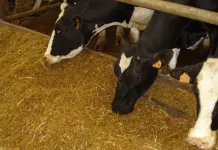Source: newindianexpress.com
Odisha is set to give buffalo breeding a big push in its efforts to increase milk production and boosting livestock sector in the State.
The Odisha Bovine Breeding Policy 2015 has laid optimum thrust on genetic improvement of buffalo population for increased milk production as well as enhance availability of economically productive milch animals in large numbers to livestock farmers.
The Department of Fisheries and Animal Resources Development (FARD) has zeroed in on the Murrah breed for upgradation of local buffaloes. Murrah has a very high milk yield with average of 15 kg per day and ranging up to even 22 kg per day.
As per the Livestock Census 2012, Odisha has around 7.26 lakh buffaloes with a female population of 3.91 lakh. The matter of concern is that the buffalo population is going down by the day and has registered a steep 39 per cent drop from 2007 Census to 2012.
The Bovine policy has made buffaloes a prime focus due to their high milk yield in comparison to cattle. It will strengthen the State Government’s plans for conservation of the indigenous buffalo breeds that include Nationally recognised Chilika and Kalahandi along with Parlakhemundi, Manda, Jerangi, Sambalpur and Kujang.
In recognised breeds like Chilika and Kalahandi, selective breeding will be taken up for improvement of the stocks. Buffalo along with cattle will progressively be brought under organised breeding through artificial insemination (AI) operations to increase female population by 40 per cent of buffaloes, 40 per cent of non-descript cattle and 70 per cent of cross bred varieties of cattle.
The policy also envisages a change in cattle breeding by undertaking a genetic upgradation programme. Germoplasms of Sahiwal, Gir and Tharparkar will be introduced in a big way while the Hariana breed will be phased out.
The Hariana breed has been in existence in the State for a long time and in-breeding has affected the species as well as milk yield. In contrast, Tharparkar can give an average milk yield of more than 10 litres per day with highest yield even reaching 19 kg per day. However, farmers’ preference would be vital for upgradation of animals.
In Binjharpuri cattle, selective breeding would be adopted for improvement of stocks as will be the case for other recognised indigenous breeds like Motu, Khariar and Ghumsari.
The Bovine Policy, which emphasises on increasing milch animal and milk production by integration of technology, has emphasised on total elimination of mating with stray bulls and intensification of AI. Scientific management and appropriate feeding practices will be inculcated in farmers.
The existing frozen semen bank at Cuttack is to be strengthened and a second semen station would be established in the State. Field AI network will also be strengthened by opening new centres and convert static stations to mobile ones.
Comments
comments


































